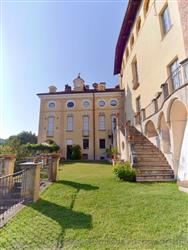|
Cossato (Biella)- Castle of Castellengo
|
|
|
Show to visit in the Biella area: |
 The Castle of Castellengo is strategically located on the tip of a hill with steep sides in the fraction Castellengo of Cossato. The Castle of Castellengo is strategically located on the tip of a hill with steep sides in the fraction Castellengo of Cossato.
Its origins date back to the early Middle Ages. According to tradition the castle was built by Alberico da Monterone in the tenth century, although it is possible that it is actually even older and that it was even born as a ricetto (fortified part of the village built by the people) rather than a castle. In any case, the castle was then taken from him for having sided with Arduino d'Ivrea.
The castle was then owned by the De Bulgaro family who took the name of "De Castellengo" from the 12th century.
Due to political disagreements between the Savoy and the Bulgaro, the latter lost the fortress, which in 1410 was divided and sold to fourteen nobles of the Biella area. For the next two centuries that of Castellengo was in fact a consortium-type castle. From the beginning of the fifteenth to the mid-nineteenth century the castle was then in the possession of the counts Frichignono of Castellengo, who also owned the fief. The castle was then divided again on various owners and went through a period of decline during which unfortunately the original furnishings and part of the paintings, frescoes, tapestries and floors were lost.
The greater part of the castle is now owned by the Ciccioni family, who are carrying out a careful restoration work both of the castle and of the park that surrounds it. A bed and breakfast is now active in the castle, while the cellars are used by the family winery, the Centovigne, which uses grapes produced in the vineyards of Castellengo, also torn from abandonment.
It is impossible to speak of an original aspect of the castle, as it has been subject to continuous modifications and additions since its origins. Its present appearance is most similar to that which it assumed in the seventeenth and eighteenth centuries, when the Frichignano transformed it from a fortess with defensive function into a noble residence.
As often happens in the case of the castles of the Biella area, the current structure is very complex, the result, as already mentioned, of countless additions, as well as modifications, so much so that it is impossible to describe it here in detail.
The castle can be reached via two roads: an older one from the northwest and a much more recent one, having been built in the nineteenth century, from the south.
Coming from the old road, the ancient defensive function of the castle is better perceived. In fact, one arrives first at a first door, called "of the Moor" and which originally was part of the outer walls of the castle, now almost completely disappeared. Note the piece of wall still remaining, on one side of the gate, and the low round tower on the other side. Their structure in river pebbles, partly arranged in a herringbone pattern, mixed with bricks testifies that they are still parts of medieval times. The door leads to a small square which, on the right, overlooks a building which was originally used to house horses and carriages and which has now been transformed into another bed and breakfast, La Carosera.
Continuing on, you enter the "lower courtyard" where the well is located, the Baroque chapel of San Giovanni built in 1727, once the noble chapel of the castle and recently restored, and the large stone staircase (1780) that leads to the "upper courtyard ". On the right, through the "green door" you reach the larger southern courtyard.
Going along the new road, currently the main road, you arrive instead to the part where the terraced gardens with a panoramic view of the plain are located. They were built in 1900 and are divided into three levels. The south side is also characterized by the presence of a tall and slender cylindrical brick tower. It was built in the fifteenth century and is crowned at the top by dovetail battlements with false machicolations.
The interior of the castle also includes various frescoed rooms. In particular, two of them are characterized by the presence of a band of frescoes placed immediately under the ceiling and depicting architectural backgrounds and landscape quadratures, baracco-style decorations probably dating back to the seventeenth century (Fig. 3, 4). One of the two rooms is further enriched by a fully painted wooden coffered ceiling decorated with geometric and plant elements (Fig. 4).
The cellars in the basement are also interesting, covered with barrel or cross brick vaults, with the only exception of the entrance hall of the well.
The castle chapel is characterized by the fact that the present convex façade was added in front of the original flat façade. The visitor is led to think that what appears to be the original façade is still recognizable behind the window in the center of the upper part of the new façade.
The chapel is accessed through a massive carved wooden door. The convex upper part also serves as the pronaos of the entrance and rests on two granite columns.
Categories: Places of historical value of artistic value
Frazione Castellengo, 31, 13836 Castellengo BI |
Castle of Castellengo: Further pictures in the section Photography |